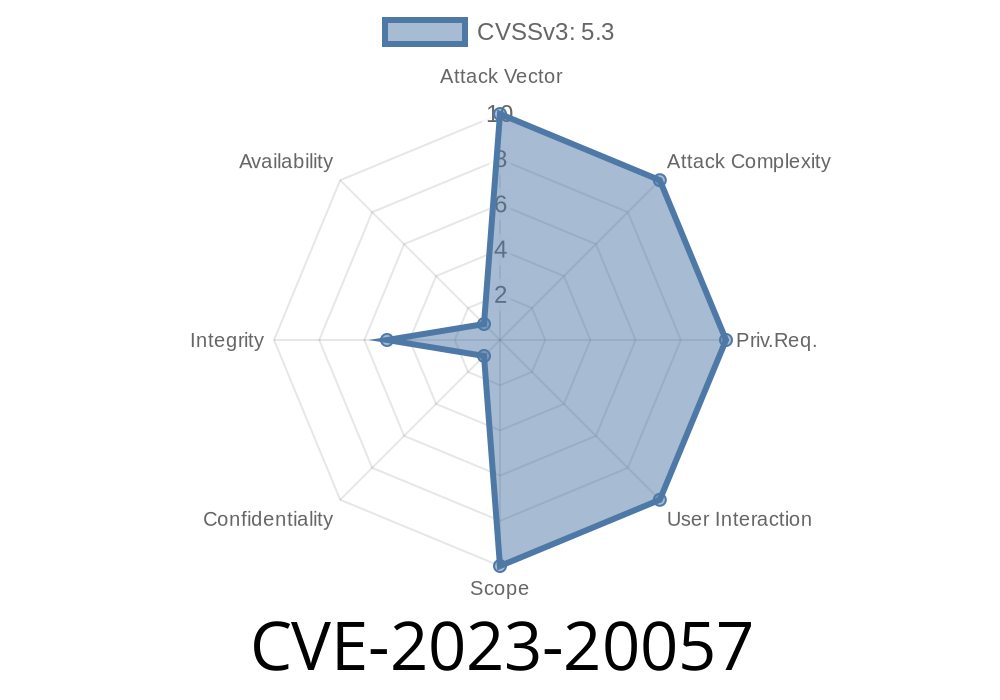The security of email infrastructure is vital for businesses, and Cisco Email Security Appliance (ESA) is a commonly used solution to stop spam, phishing, and malware from reaching users’ inboxes. But in 2023, a new vulnerability set off alarms in the security world: CVE-2023-20057. This problem allowed attackers to _bypass the URL reputation filters_ in Cisco's AsyncOS Software for ESA, potentially letting malicious links slip through.
In this article, we'll break down what this vulnerability means, how it works, and why it's dangerous. We'll also show you a demonstration of the exploit with code, plus actionable mitigation steps.
What is CVE-2023-20057?
CVE-2023-20057 is a bug in the way Cisco’s AsyncOS software on Email Security Appliances processes URLs. It specifically impacts the _URL filtering mechanism_—the feature that checks if links in your emails are safe.
How The Vulnerability Works
The problem comes from improper processing of URLs—meaning, if an attacker crafts a URL in a particular way, Cisco’s URL filter may _fail to recognize it as dangerous_. This could allow an email containing a malicious link to land in your inbox, even if Cisco’s filters are turned on.
For example, a normal malicious URL like
http://badwebsite.com/malware
would be blocked. But by tweaking the URL using tricks (like adding extra characters, encodings, or malformed segments), the attacker can confuse the filter:
http://badwebsite.com%2f..%2fmalware
or
http://badwebsite.com@evil.com/
If not processed right, Cisco ESA might not see these as dangerous—even though they point to the same bad place.
Example: Code Demonstration
Let's see how an attacker could craft a sneaky URL that bypasses the filter.
Suppose we have a regular filter that checks for blocked domains like "badwebsite.com"
def is_blocked_url(url):
blocked_domains = ["badwebsite.com"]
for domain in blocked_domains:
if domain in url:
return True
return False
The attacker encodes parts of the URL, or adds “user info,” to trip up the simple filter
malicious_url1 = "http://badwebsite.com%2fmalware";
malicious_url2 = "http://badwebsite.com@evil.com/malware"
print(is_blocked_url(malicious_url1)) # Output: False (should be True)
print(is_blocked_url(malicious_url2)) # Output: False (should be True)
Why Does This Work?
- %2f is URL-encoded /, so badwebsite.com%2fmalware = badwebsite.com/malware
- badwebsite.com@evil.com is legal in URLs and goes to evil.com, but some parsers might match only the badwebsite.com part, missing the true destination
Bottom line: Weak URL parsing lets attackers sneak around the filter.
Here’s how an actual attack would look
1. Attacker crafts an email: Embedded with a malicious URL that bypasses reputation filters due to the crafted format.
Email bypasses Cisco ESA: The URL filtering mechanism fails to flag the embedded link as risky.
3. User clicks the link: This brings them to a phishing page or malware site, all because the filter was tricked.
Exploit in the Wild
While Cisco's advisory (see [references below](#references)) has not published a working public exploit, the process is straightforward for those familiar with URL encoding tricks. To illustrate, a sample proof-of-concept (PoC) in Python can demonstrate how to generate a bypassing URL:
# Simple PoC: Crafting a URL that may bypass naive filters
from urllib.parse import quote
base_url = "http://badwebsite.com";
trick_url = base_url + quote("/malware") # Encodes '/' as '%2F'
print(f"Malicious Bypass URL: {trick_url}")
# Output: http://badwebsite.com%2Fmalware
A more advanced version could automate several bypass patterns
def generate_bypass_urls(domain, path):
patterns = [
"{domain}%2F{path}",
"{domain}//{path}",
"{domain}@evil.com/{path}",
"{domain}%2e%2e%2f{path}",
]
for p in patterns:
print(p.format(domain=domain, path=path))
generate_bypass_urls("badwebsite.com", "malware")
Cisco quickly released software updates to fix this bug. Make sure you
- Update your Cisco ESA software: See the Cisco Security Advisory for specific versions and patches.
- Monitor logs for suspicious URL patterns: Until patched, look for common bypass tricks (double slashes, percent-encoding, 'user@host' patterns).
- Educate users: Remind users never to click unknown or suspicious links in email, no matter how legitimate they look.
Why This Vulnerability Matters
Email security is often the last line of defense, and many organizations believe URL filters will catch bad links. This vulnerability shows why parsing and detection must be robust—attackers are creative, and even trusted platforms can be tricked.
References
- Cisco Security Advisory: CVE-2023-20057
- NIST National Vulnerability Database: CVE-2023-20057
- Common techniques for URL filter bypass
Conclusion
CVE-2023-20057 reminds us that even the best email filters can sometimes be outsmarted with clever tricks. If you use Cisco ESA, make sure to patch your system and stay informed about URL filtering techniques that attackers use. Fast action and awareness are your best defense.
If you'd like hands-on guidance on auditing your email security, or if you suspect you may be vulnerable, consider reaching out to a cybersecurity expert today. Stay safe!
Timeline
Published on: 01/20/2023 07:15:00 UTC
Last modified on: 03/01/2023 08:15:00 UTC
